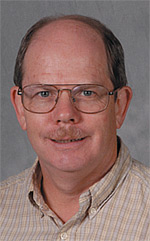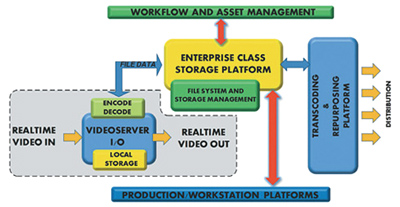Appliances for an IT-Based World

Several years ago, this author prognosticated that video server systems might eventually be thought of as simply "appliances," that is, small footprint devices that provide the conduit between streamed real-time or live video and a storage medium or vice versa.
This prediction came before the prevalence of software-based codecs, solid-state flash-based caching, terabyte-sized disk drives, and high-performance, multi-hundred terabyte data storage engines.
Video server technologies have come a long way since this column first surfaced some 12-plus years ago. The merging of video serving onto graphics and transition-based video platforms has already taken place. Clips stores have been in production servers for probably a decade. Video servers for PCs, gaming and Internet platforms are nothing new. Even digital SLR cameras have added HD video image capturing with 4 GB files in 720p and 1080p24 content created with H.264 codecs and stored as QuickTime movies. We've come a long way since Betacam SP!
A NEW TREND
Another marker is about to be set on this same evolutionary timeline. An emerging trend furthering the prediction that videotape is dead surfaced in earnest this past year.
That trend is taking the physical footprint, i.e., the same dimensions as the VTR, and changing it to a fully flexible, spinning disk or solid-state capture and storage platform that retains a modest amount of content for localized play-out or be coupled as one component in an enterprise level media storage, asset management or post-production/play-out services platform. And here's where the differences begin to surface.
Heretofore, most professional broadcast video servers' capturing components were either discrete ports or card-based modules that were integrated with a self-contained set of disks for storage or were ports coupled with a NAS or SAN system that was purposely built for that port's architecture.
As this concept becomes a little long in the tooth, and the costs for an entire system begin to escalate, manufacturers started to recognize a need for standalone, small footprint-serving platforms that can either remain standalone or can be configured into a larger system as demand dictates.

Fig. 1: This diagram illustrates how a video server appliance (in the gray dotted-line section) could be integrated into a larger scale system that incorporates enterprise class or high-performance hierarchical storage with workflow and asset management functions. Often this standalone system will be sufficient for a secondary play-out channel, a record/play-out device in a mobile sports or venue application, or as a backup to the primary air chain or a disaster recovery element at a remote site.
These appliance-like video serving platforms are employed in automated transmission and play-out systems, and in nonbroadcast production systems at entertainment venues.
The future may be in the area where enterprise class media outlets need to perform a number of production tasks, but don't require the mission-critical caliber of components to accomplish their objectives.
In this latter mode of operation, regardless of the scale or intensity of routines, it may be highly desirable to couple the file-side of the video server appliance into a large-scale, enterprise-class storage platform that incorporates transcode engines, streaming media or video-on-demand components.
Here is where the higher-performance codecs and concepts of the professional video serving platform, as an appliance, make sense. Fig. 1 gives a representation of how a video server appliance (in the gray dotted-line section) could be integrated into a larger scale system that incorporates enterprise class or high-performance hierarchical storage with workflow and asset management functions.
When the video server is required for ingest or play-out, it will utilize the local storage and its own—usually software-based—encoder/decoder integration. Files are then FTP'd to or from the main storage platform where they are managed separately from the ingest/play-to-air components.
Adjunct workflow processes—such as production or graphics that utilize these files and others generated throughout the production or repurposing processes—are separately managed away from the dedicated video server appliance.
Any asset management, which would include associated text, graphics, stills or other forms of media, are integrated through channels specifically designed for the enterprise class environment. When content, as files, are needed for distribution, they are managed on the transcoding and repurposing platform, which is specifically architected for those activities.
THE CONFIGURATION
There are a number of different ways to configure a system like the one depicted. Service-oriented architectures (SOA) might show this as a circle structure where the activities can be distributed around or from a central core. The storage platform could be detailed to show differing levels of "tiered" storage, including SATA or iSCSI drives for some activities, Fibre Channel drives for high-speed activities including rendering, and even library or archive components with spinning disks or LTO tape drives.
Often the enterprise storage platform will incorporate its own file system with its own storage management engines that are optimized for the hardware and software applications utilized to increase performance. This also opens the door for storage virtualization, without disrupting the core functions of the video server platform.
Backup and offsite storage, i.e. disaster recovery, as well as collaborative work processes extended across wide area networks, can all be added to this environment in levels and classes that are independent of the video server input/output and encoding functions.
And should the user decide to add, subtract or redistribute those ingest and/or play-out functions, the server component(s) are easily relocated or appended to the system without impacting the other sub-systems.
What is most important to understand when looking to this type of appliance-based architecture is that the functionality of each subsystem can be tailored for an optimal price-to-performance equation.
For example, as the video server components need upgrading, or they become obsolescent, they are easily "exchanged" for other components well into the future. "Forklift" upgrades to meet objectives yet undefined by the working environment become unnecessary.
This vision to the future is not far off. At least a few of the broadcast professional video server manufacturers have already adopted an approach that lends their modular product lines to this scenario.
Thus, there becomes a true harmonization of IT-centric systems to real-time video systems, obtained with the least amount of interoperability issues.
Karl Paulsen is chief technology officer for AZCAR Technologies. Karl is a SMPTE Fellow and an SBE Life Member and Certified Professional Broadcast Engineer. Contact him atkarl.paulsen@azcar.com.
Get the TV Tech Newsletter
The professional video industry's #1 source for news, trends and product and tech information. Sign up below.

Karl Paulsen recently retired as a CTO and has regularly contributed to TV Tech on topics related to media, networking, workflow, cloud and systemization for the media and entertainment industry. He is a SMPTE Fellow with more than 50 years of engineering and managerial experience in commercial TV and radio broadcasting. For over 25 years he has written on featured topics in TV Tech magazine—penning the magazine’s “Storage and Media Technologies” and “Cloudspotter’s Journal” columns.
